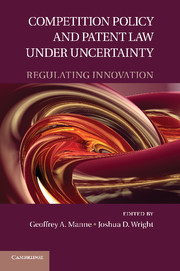Book contents
- Frontmatter
- Contents
- Contributors
- Introduction
- PART I THE INSTITUTIONS OF GROWTH
- PART II THE ECONOMICS OF INNOVATION
- 3 Bundling and Unbundling in New Technology Markets
- 4 Unlocking Technology
- 5 Creative Construction
- PART III INNOVATION AND COMPETITION POLICY
- PART IV THE PATENT SYSTEM
- PART V PROPERTY RIGHTS AND THE THEORY OF PATENT LAW
- PART VI INTELLECTUAL PROPRETY AND ANTITRUST: THE REGULATION OF STANDARD-SETTING ORGANIZATIONS
- Index
- References
5 - Creative Construction
Assimilation, Specialization, and the Technology Life Cycle
Published online by Cambridge University Press: 05 June 2012
- Frontmatter
- Contents
- Contributors
- Introduction
- PART I THE INSTITUTIONS OF GROWTH
- PART II THE ECONOMICS OF INNOVATION
- 3 Bundling and Unbundling in New Technology Markets
- 4 Unlocking Technology
- 5 Creative Construction
- PART III INNOVATION AND COMPETITION POLICY
- PART IV THE PATENT SYSTEM
- PART V PROPERTY RIGHTS AND THE THEORY OF PATENT LAW
- PART VI INTELLECTUAL PROPRETY AND ANTITRUST: THE REGULATION OF STANDARD-SETTING ORGANIZATIONS
- Index
- References
Summary
Introduction and Overview
All too often, practitioners, pundits, and academics take a pessimistic view of the value and longevity of today's technologies. We all fall in love with new, apparently “disruptive” technologies, like Linux or on-line music distribution, and preach the death of established organizations and existing capabilities. However, the reality is often different and more subtle: The old mantra of “creative destruction” seldom applies in a holistic fashion. Old technologies and capabilities rarely disappear – they instead evolve and become the building blocks of tomorrow's innovations. They provide crucial, enduring value to established firms, new entrepreneurs, and consumers alike. This simple realization has crucial implications for managers and policy makers.
This chapter takes a new look at the innovation life cycle and its implications for competition and public policy. It draws from existing literature, case studies, and product innovation data to illustrate the workings of technological “assimilation,” namely, how technological innovations that were once marketed as individual products become integrated into broader platforms, which in turn provide the building blocks of further innovation. As we will illustrate through our examples, assimilation can take various forms and impact various levels of integration, such as the incorporation of capabilities into a new distribution platform, the licensing of complementary capabilities, and, in some cases, acquisitions of entire companies with complementary products or technology assets.
Information
- Type
- Chapter
- Information
- Competition Policy and Patent Law under UncertaintyRegulating Innovation, pp. 166 - 200Publisher: Cambridge University PressPrint publication year: 2011
